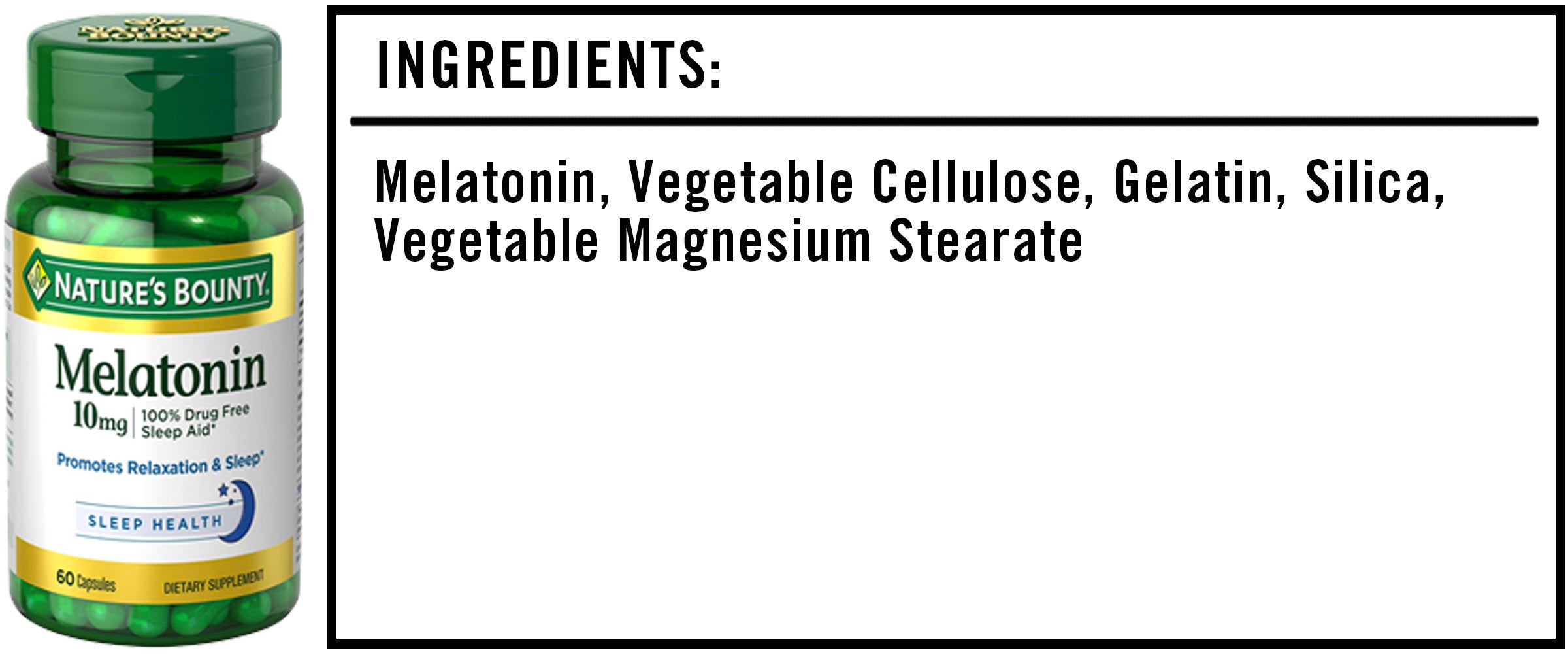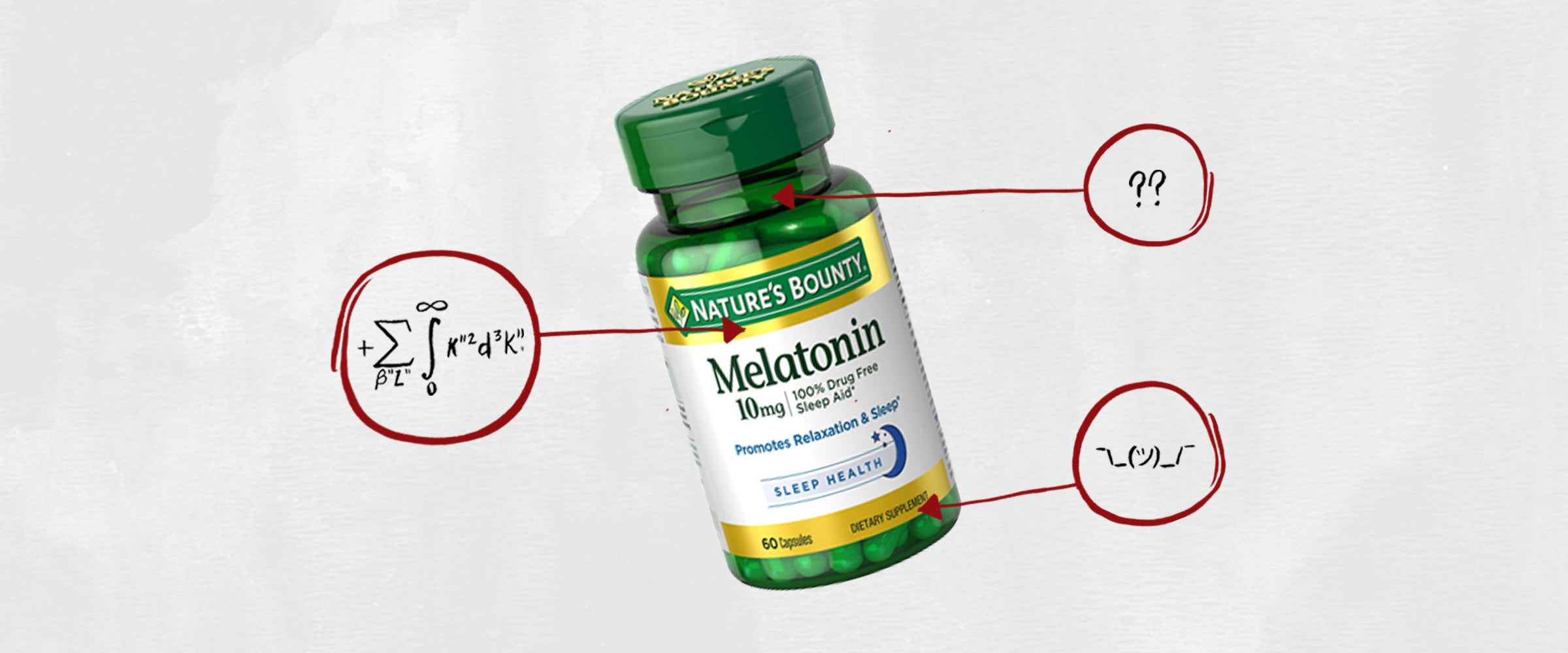We’re often told that you should never eat anything (or put anything on your body) if you don’t recognize everything on the ingredients list. But since most of us have no idea what xanthan gum or potassium benzoate are — or more importantly, what they’re doing to our bodies — we’re decoding the ingredients in the many things Americans put in (and on, or near) themselves.
This edition: Nature’s Bounty Melatonin supplements, which are made from five separate ingredients that we’ve broken down in the exact order they appear on their website.

The Ingredients
1) Melatonin: Melatonin is a hormone naturally produced by the body, secreted by the pineal gland, that controls our sleep-wake cycle. Essentially, a working pineal gland should release melatonin when the sun sets, several hours before we usually go to sleep, which should then help induce sleepiness. Therefore, many, many people believe that supplementing melatonin will help them fall asleep and stay asleep; in fact, Americans spent approximately $408 million on melatonin in 2017. As with many supplements, though, the actual science is dicey.
On one hand, research does suggest that people with a delayed sleep-wake phase disorder, where they consistently fall asleep very late and wake up late the next day, might benefit from melatonin. For more common forms of insomnia, however, the effects are less dramatic: A 2013 meta-analysis found that people with insomnia fell asleep a measly seven minutes faster with melatonin than with a placebo. Then again, hey, every minute counts.
Because of how our natural melatonin secretion works — it makes us sleepy when the sun sets — a lot of night-shift workers take melatonin supplements in an attempt to fall asleep during the day, and many claim that it works. However, as Terry Cralle, certified clinical sleep educator and author of Sleeping Your Way to the Top: How to Get the Sleep You Need to Succeed, explains, “According to two research reviews published in 2014, studies on whether melatonin supplements help shift workers were generally small or inconclusive.”
All that said, one of the most common side effects of melatonin is drowsiness the next day, especially when people take higher doses than they should or take the supplement for more than a couple of months — little data shows that taking melatonin for any longer than three months is safe. So if taking melatonin makes you feel zonked out the next morning, surely seven more minutes of sleep the night before might not be so worthwhile. Moreover, because of the drowsiness associated with melatonin, you should use caution when driving after taking it — even the next morning.
Speaking of side effects, melatonin is notorious for inducing vivid dreams and nightmares, too. While dreams in general are a shaky science, loads of anecdotal evidence supports this phenomenon. Take, for instance, this story on Reddit about a melatonin-induced Christmas/psychedelic dream:
“I found myself in sleep paralysis at one point during the night and decided to stick with it to transition into a lucid experience. Incredibly strange and alien sounds emerged into my awareness and for some reason, I inserted thoughts about Christmas and Santa Claus. I was transported into some grid-like room very similar to the training room in Street Fighter. I was in my bed hovering in this room and jumped out to see three giant-sized nutcrackers dancing like robots. I high-fived one of them and then I proceeded to see trippy visuals with things like candy canes and reindeer flying past me.”
Sounds pretty sweet, actually.
One other thing to consider is that melatonin supplements like these are largely unregulated. “As such,” Cralle explains, “the quality and precise dosage of products available in health food stores and other outlets is uncertain. A study published in 2017 tested 31 different melatonin supplements purchased from pharmacies and grocery stores. For most of the supplements tested, the amount of melatonin in the product did not match what was listed on the label.”
In the end, you can try melatonin if you want, but start with small doses, only take it for short periods of time, and most importantly, consult with your doctor. And remember, the evidence behind melatonin is lacking, which is why even the American Academy of Sleep Medicine recommends clinicians not use melatonin as a treatment for insomnia. In other words, don’t get your hopes up.
2) Vegetable Cellulose: Cellulose is essentially the structural component of all plants and is often used to make tasteless and odorless capsules, where the melatonin is situated.
3) Gelatin: In pharmaceuticals, like these capsules, gelatin is used to make up the bulk of pills. One thing of note: Gelatin is often derived from various animal parts, so vegetarians and vegans beware.
4) Silica: Silica, also known as silicon dioxide, is a natural compound that can be found in water, plants, animals and the earth itself — the crust is 59 percent silica. It plays a basic role in supplements and capsules, preventing the various powdered ingredients from sticking together.
5) Vegetable Magnesium Stearate: Magnesium stearate is a fine white powder that, similar to silica, is frequently used as a release agent, meaning it prevents the various individual ingredients in these capsules from sticking to each other (and the machines) during production.
The Takeaway
While some evidence suggests that melatonin might help certain people fall asleep quicker, the science still falls short, and as Cralle says, “The effects are modest at best.” So, give it a shot if you want, but honestly, as far as research is concerned, a cup of hot chamomile tea probably works just as well.

